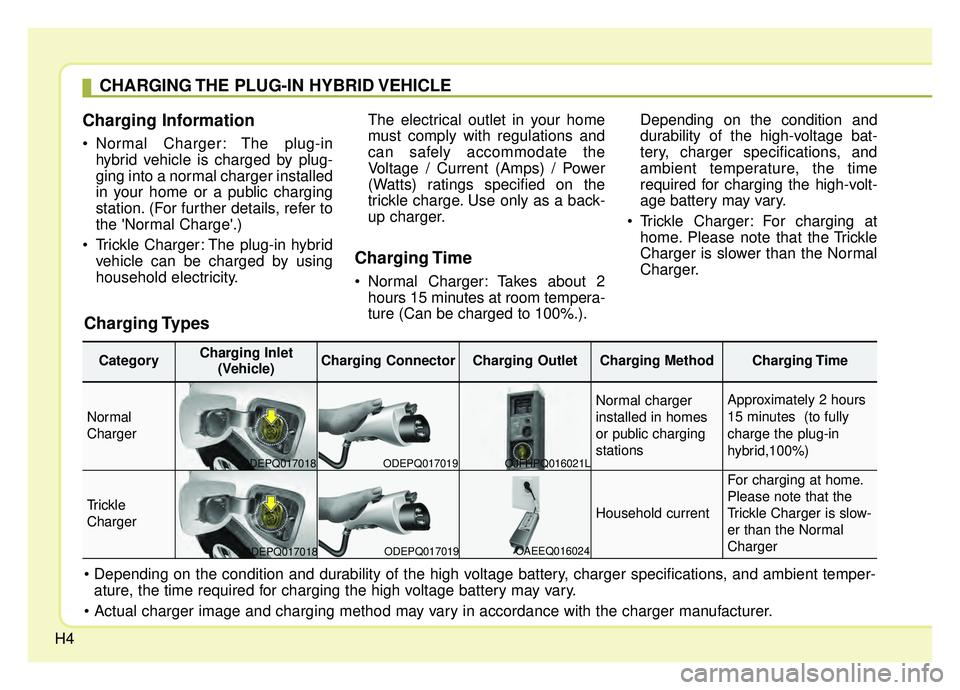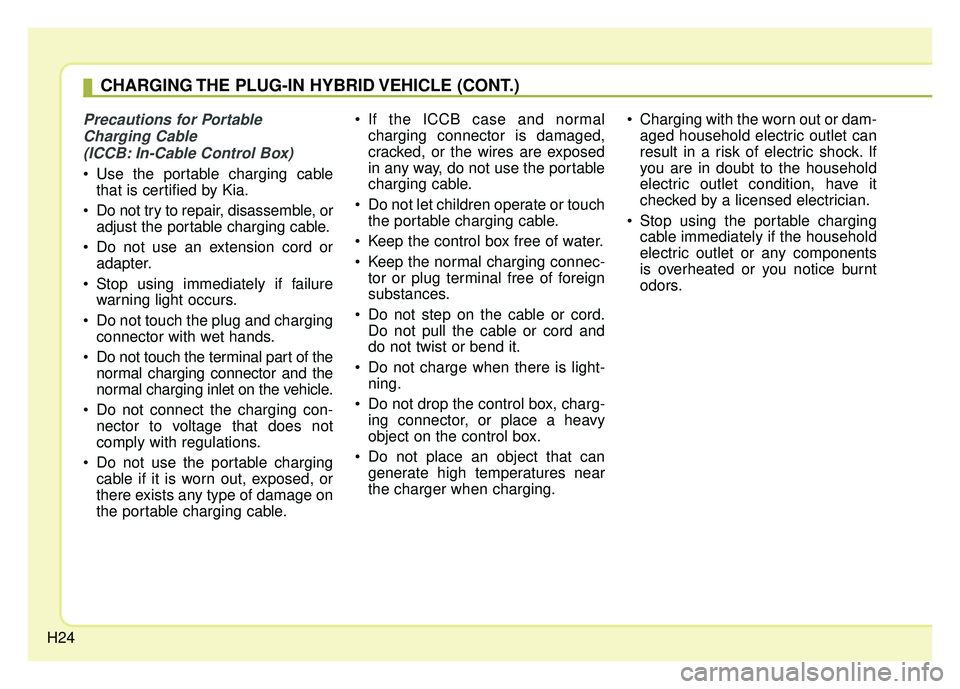Page 8 of 616
H2
HEV (HYBRID ELECTRIC VEHICLE) SYSTEM
The Kia Hybrid Electric Vehicle (HEV) uses both the gasoline engine and the electric motor for power. The electric
motor is run by a 360V high-voltage HEV battery.
Depending on the driving conditions, the HEV computer selectively operates between the engine and the electric
motor or even both at the same time.
Fuel efficiency increases when the engine is at idle, or when the vehicle is driven by the electric motor with the HEV
battery.
The HEV battery charge must be maintained for the times when the engine acts as a generator, such as when
stopped at idle. Charging also occurs when decelerating or by regenerative braking.
ODEP057140L
Startup/Low speed cruiseAcceleration High speed cruise DecelerationStop
Electric motorElectric motor+EngineEngine+
Motor or MotorChargingEngine OFF
Page 10 of 616

H4
Charging Information
• Normal Charger: The plug-inhybrid vehicle is charged by plug-
ging into a normal charger installed
in your home or a public charging
station. (For further details, refer to
the 'Normal Charge'.)
Trickle Charger: The plug-in hybrid vehicle can be charged by using
household electricity. The electrical outlet in your home
must comply with regulations and
can safely accommodate the
Voltage / Current (Amps) / Power
(Watts) ratings specified on the
trickle charge. Use only as a back-
up charger.
Charging Time
Normal Charger: Takes about 2
hours 15 minutes at room tempera-
ture (Can be charged to 100%.). Depending on the condition and
durability of the high-voltage bat-
tery, charger specifications, and
ambient temperature, the time
required for charging the high-volt-
age battery may vary.
Trickle Charger: For charging at home. Please note that the Trickle
Charger is slower than the Normal
Charger.
CHARGING THE PLUG-IN HYBRID VEHICLE
Charging Types
ature, the time required for charging the high voltage battery may vary.
CategoryCharging Inlet (Vehicle)Charging ConnectorCharging OutletCharging Method Charging Time
Normal
Charger
Normal charger
installed in homes
or public charging
stations Approximately 2 hours
15 minutes (to fully
charge the plug-in
hybrid,100%)
Trickle
ChargerHousehold current
For charging at home.
Please note that the
Trickle Charger is slow-
er than the Normal
Charger
ODEPQ017018 ODEPQ017019
ODEPQ017019 OAEEQ016024
OJFHPQ016021L
ODEPQ017018
Page 11 of 616
H5
Charging Status
You can check the charging status at
the outside of vehicle when charging
or using (it is not driving status) the
high-voltage battery.
➀: Charging indicator lamp
Charging Connector
AUTO/LOCK Mode
You may select when the charging
connector can be locked and
unlocked in the charging inlet.
Press the button to change
between AUTO mode and LOCK
mode.
ODEP047020N
ODEPQ017021
Operation of
Charging Indicator Lamp (1)
Charging Status
Turns on (Green)Charging inprogress
Turns offNot Charging or fully charged
Slowly blinks
(Green) and then turns off (repeat for 3 minutes)Waiting for sched- uled charging
(turns off after 3 minutes)
Quickly
blinks(Green) and then turns off
(repeats during operation)
Aux. Battery Saver+ operating in progress
Slowly blinks (Red)Malfunction
Page 18 of 616

H12
6. Check if the charging cable con-nection indicator of the high volt-
age battery in the instrument clus-
ter is turned ON.
Charging does not occur when the
indicator is OFF. When the charg-
ing connector is not connected
properly, reconnect the charging
cable to charge.
✽ ✽ NOTICE
• Charging is in progress only when
the shift lever is in P (Park).
Charging the battery with the
Engine Start/Stop button in the
ACC position is possible. However,
it may discharge the 12-V battery.
Thus, if possible, charge the bat-
tery with the Engine Start/Stop
button in the OFF position.
• The charging process is interrupt- ed temporarily when the shift lever
is moved from P (Park) to Not P(R
(Reverse)/N (Neutral)/D (Drive))
during charging. To resume(restart)
charging, move the shift lever to the
P (park) position. Then, the charging
process is resumed(restarted).
7. After charging has started, the
estimated charging time is dis-
played on the instrument cluster
for about 1 minute. It is also dis-
played, when the driver’s door is
opened with charging in progress.
When scheduled charging is set,
the estimated charging time is dis-
played as “--" .
ODEPQ017027
CHARGING THE PLUG-IN HYBRID VEHICLE (CONT.)
ODEPQ017028L
Page 19 of 616
H13
Unlock Connector in Emergency
If the charging connector does not
unlock for some reason, open the
hood and slightly pull the emergency
cable as shown above. The charging
door will then open.
If a charging door is not opened
immediately with emergency cable in
operation, press a charging door
lightly and pull emergency cable
again.
Charging Status
Checking Charging Status
You can check the charging status at
the outside of vehicle when charging
or using (it is not driving status) the
high-voltage battery.
ODEPQ017029
ODEP047020N
Operation of
Charging Indicator Lamp (1)
Charging Status
Turns on (Green)Charging inprogress
Turns offNot Charging or fully charged
Slowly blinks
(Green) and then turns off (repeat for 3 minutes)Waiting for sched- uled charging
(turns off after 3 minutes)
Quickly
blinks(Green) and then turns off
(repeats during operation)
Aux. Battery Saver+ operating in progress
Slowly blinks (Red)Malfunction
Page 23 of 616
H17
6. Remove any dust on the chargingconnector and charging inlet.
7. Hold the charging connector han- dle. Then, insert it into the charging
inlet, until you hear a click sound. If
it is not fully connected, improper
connection between the charging
connector and the charging termi-
nals are a potential fire hazard. 8. Charging starts automatically and
the charging light blinks. 9. Check if the charging cable con-
nection indicator of the high volt-
age battery in the instrument clus-
ter is turned ON.
Charging does not occur when the
indicator is OFF. When the charg-
ing connector is not connected
properly, reconnect the charging
cable to charge.
ODEPQ017035ODEPQ017027
ODEPQ017049
ODEPQ017048
■ Vehicle connection ■
Charge
Page 25 of 616
H19
Charging Status
You can check the charging status at
the outside of vehicle when charging
or using (it is not driving status) the
high-voltage battery.
Charge cable storage
We recommend that the trickle
charger cable should be put in a stor-
age box after use.
ODEP047020NODEPQ017033
Operation of
Charging Indicator Lamp (1)
Charging Status
Turns on (Green)Charging inprogress
Turns offNot charged or fully charged
Slowly blinks
(Green) and then turns off (repeat for 3 minutes)Waiting for sched- uled charging
(turns off after 3 minutes)
Quickly
blinks(Green) and then turns off
(repeat during operation)
Aux. Battery Saver + operating in progress
Slowly blinks (Red)Malfunction
Page 30 of 616

H24
Precautions for PortableCharging Cable (ICCB: In-Cable Control Box)
Use the portable charging cable that is certified by Kia.
Do not try to repair, disassemble, or adjust the portable charging cable.
Do not use an extension cord or adapter.
Stop using immediately if failure warning light occurs.
Do not touch the plug and charging connector with wet hands.
Do not touch the terminal part of the normal charging connector and the
normal charging inlet on the vehicle.
Do not connect the charging con- nector to voltage that does not
comply with regulations.
Do not use the portable charging cable if it is worn out, exposed, or
there exists any type of damage on
the portable charging cable. If the ICCB case and normal
charging connector is damaged,
cracked, or the wires are exposed
in any way, do not use the portable
charging cable.
Do not let children operate or touch the portable charging cable.
Keep the control box free of water.
Keep the normal charging connec- tor or plug terminal free of foreign
substances.
Do not step on the cable or cord. Do not pull the cable or cord and
do not twist or bend it.
Do not charge when there is light- ning.
Do not drop the control box, charg- ing connector, or place a heavy
object on the control box.
Do not place an object that can generate high temperatures near
the charger when charging. Charging with the worn out or dam-
aged household electric outlet can
result in a risk of electric shock. If
you are in doubt to the household
electric outlet condition, have it
checked by a licensed electrician.
Stop using the portable charging cable immediately if the household
electric outlet or any components
is overheated or you notice burnt
odors.
CHARGING THE PLUG-IN HYBRID VEHICLE (CONT.)